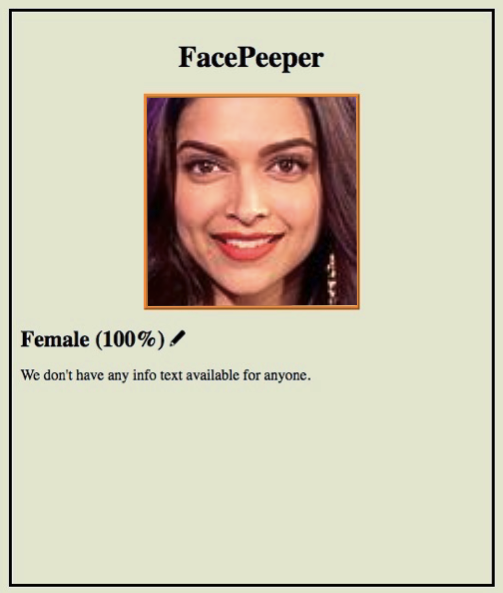A Deep Residual Convolutional Neural Network as gender classifier on an interactive webserver. The network is implemented in Tensorflow an optimized with ADAM
- University of Osnabrück
- Winter Term 2016/17
- Course: Introduction to Artificial Neural Networks with Tensorflow
- Contributors: Clemens Hutter, Michele Pariani, Jannik Steinmann, Jannis Born
- Full:
- Python 3.x
- Tensorflow 1.x
- openCV
- Scrapy
- C++ Compiler (OS X, Linux or Visual Studios on Windows)
- Webserver access
- Scipy
- Partly (functionality verification)
- Python 3.x
- Tensorflow 1.x
- Scipy
Feel free to fork.
For this project we crawled pictures from ca. 400 celebrities from the Image Movie Database (IMDB). These images were face-cropped and initially used to train a 33-layer Residual Convolutional Neural Network (according to He et al., Deep Residual Learning for Image Recognition (2015) ) to differentiate the identities of these 400 celebrities. Due to time constraints, we simplified the architecture to a 9-layer residual CNN trained on a cross-individual gender classification. On the frontend, we provide an interative webserver on which a user verify the network's gender prediction of an arbitrary uploaded image. In case of wrong classification the user has the option to provide the correct label and retrain the network.
- The Crawler folder contains the code necessary to crawl the images from IMDB
- The network implementation can be found in residualCNN.py.
- An extensive report of the project is in REPORT.pdf
- The network is implemented in Tensorflow and allows access from the folders GenderClassifier,
IdentityClassifier and MNIST_Classifier, 3 exemplary tasks that can be solved with the network. They have very similar structures, each containing a Trainer.py file
(that trains on the particular task from scratch) and a Tester.py file (that restores our pretrained weights and tests model
performance). They also output performance visualizations. The initial task,
identitiy classification could not be solved properly although learning slowly began after some time (and that only after reducing
depth of the network). We verified the soundness of the network by classifying the MNIST dataset where we achieved a test
accuracy of 99.56%. Subsequently, we used a subset of the 400-class celebrity dataset to train the network on gender classifcation
task where we achieve 96.4% on the test dataset.
- To restore the trained networks the weights can be found on PolyBox
- For smooth execution, please place the weight file in the respective folder (e.g. weightsIdentity.ckpt in IdentityClassifier)
- Please consider, that for the GenderClassification we used once a traditional and once an augmented dataset (according to Krizhevsky et al. ImageNet Classification with Deep Convolutional Neural Networks (2012)). You can specify which version/weights you want to use via a Boolean at the beginning of the training file.
- The FacePeeperGUI folder provides the code for the interactive frontend where a user can a) upload and classify any image (given a single face is found) and b) correct misclassifications of the network. It is implemented in a combination of Python, HTML and JavaScript and the webserver can be made temporarily available via Amazon Web Services (AWS) upon request.
- The Helper folder contains a preProcessing file (normalization, PCA of RGB augmentation), the results of the PCA, a MATLAB function used to crop the crawled images, a plot visualizing the effect of image normalization and augmentation, and some backup files for the frontend.
- The folders TrainData and TestData contain selections of the crawled images, please leave them untouched.
